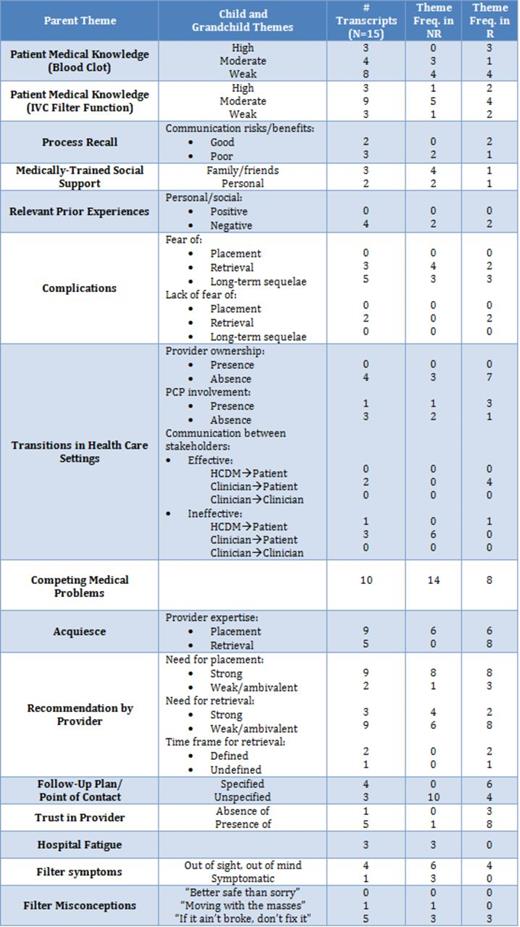Abstract
Introduction: While the majority of retrievable inferior vena cava filters (rIVCFs) are candidates for retrieval once the risk of thrombosis or bleeding has subsided, only ~ 20% of IVCFs are retrieved. Lack of patient follow-up is cited as the primary contributor to low retrieval rates. However, studies have not examined patient-perceived factors that lead to poor follow-up.
Methods: This is a single center cross-sectional mixed methods study. Adult patients who received a rIVCF at our institution from 2008-2011 were included. Patients were excluded if it was decided to leave the IVCF in permanently. Eligibles were dichotomized into IVCF retrieved (R) versus not-retrieved (NR). A random sample of 100 patients (50 per group) was contacted for an individual face-to face interview. Target enrollment was 35 patients per group until thematic saturation was reached. The healthcare decision maker (HCDM) was invited to the interview if he/she provided consent to have the IVCF placed. Individual interviews were conducted by a hematologist and a health communications expert. Interviews focused on predisposing, enabling, reinforcing, situational, and procedural-related factors that may have affected IVCF retrieval. Transcripts of the interviews were analyzed by a multi-disciplinary team to identify and consolidate impressions into a list of themes elucidating facilitators and barriers to IVCF retrieval. Transcripts were coded according to finalized themes utilizing a cross-platform application for analyzing qualitative data.
Results: 808 adult patients who received an IVCF at our institution from 2008-2011 were identified (R= 146, NR= 658). Thematic saturation was reached after the first fifteen interviews (8R and 7NR). 33.3% of subjects had a HCDM that consented for IVCF placement. 66.7% were male; 60% of IVCFs were placed for primary VTE prophylaxis despite only 26.7% having a contraindication to anticoagulation at the time of placement, 53.3% were placed by interventional radiology and 46.7% by vascular surgery, 53.5% had an IVCF placed during an admission for trauma; 40% had a history of prior VTE. The average time from hospital admission to IVCF placement was 3.7 days. Of the 8 patients that had their IVCF retrieved, the average time to retrieval was 279 days. Commonly expressed themes associated with retrieval or non-retrieval are depicted in Table 1.
Conclusion: This study is unique in that it explores patient-related facilitators and barriers to IVCF retrieval. Preliminary results indicate that differences in themes expressed by patients may contribute to likelihood of retrieval. Results from this study will be used to develop and prospectively pilot a patient-centered educational resource toolkit for patients with IVC filters to enhance shared-decision making and overcome obstacles to IVCF retrieval.
Rajasekhar:Anticoagulation Forum/Boston University: Speakers Bureau; Alexion: Membership on an entity's Board of Directors or advisory committees; Baxter: Membership on an entity's Board of Directors or advisory committees; Octapharma: Membership on an entity's Board of Directors or advisory committees.
Author notes
Asterisk with author names denotes non-ASH members.


This feature is available to Subscribers Only
Sign In or Create an Account Close Modal